I've been listening to the Pass Labs XP-17 phono preamp in various system configurations for a while now to get a feel for its overall performance, and its versatility in combining with other equipment, so I thought I'd provide an update as I work towards the XP-17's feature review for Positive Feedback.

Pass Labs XP-17 phono preamplifier.
To quote the Pass Labs website about the XP-17:
"XP-17 uses the new-shielded low noise toroid and input filter module, like the XP-12 (my review HERE). The power supply has an extra stage of RC filtering. We have lower radiated and mechanical noise.
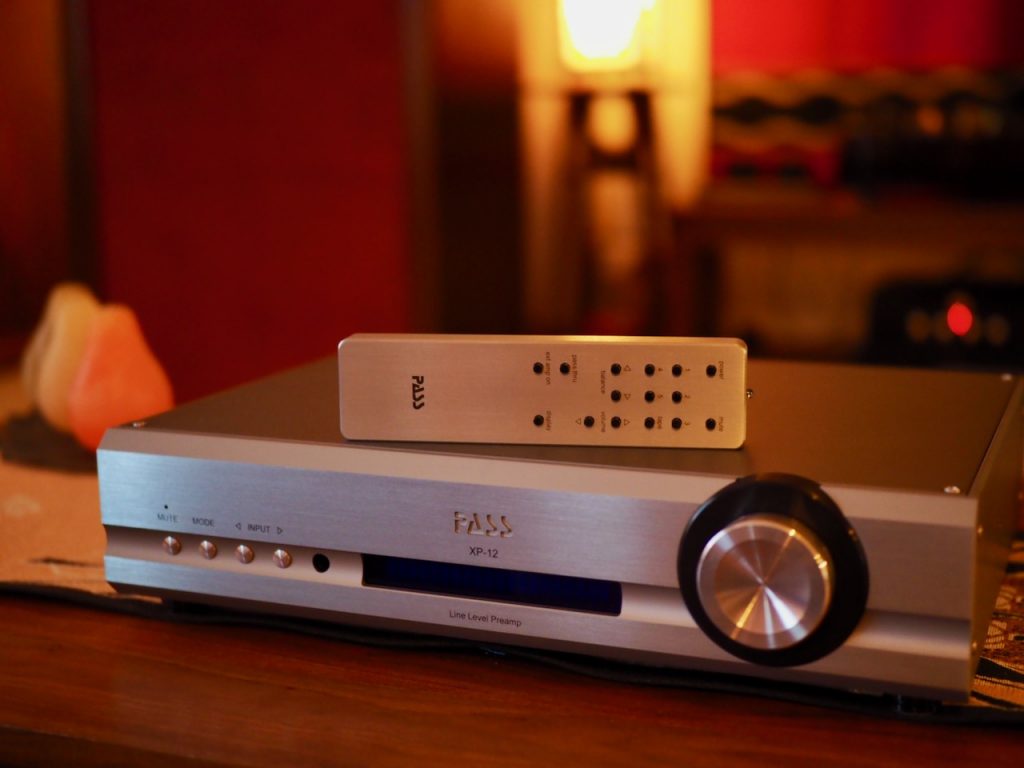
Pass Labs XP-12 preamplifier and remote control.
"The XP-17 has an all-new input circuit that is symmetrical and lower in noise and distortion with greater drive capability. Noise is the most prominent part of THD+N in the first section of a phono stage. By lowering noise we get better resolution and dynamics.
"Designed with a split EQ network like the XP 25 and XS Phono that is more accurate and can handle greater signal levels.
"The secondary stage runs a higher bias output stage with auto bias.
"The numerous loading options from the XP-15 are all still available and three gain settings to accommodate low output MC to MM cartridges."
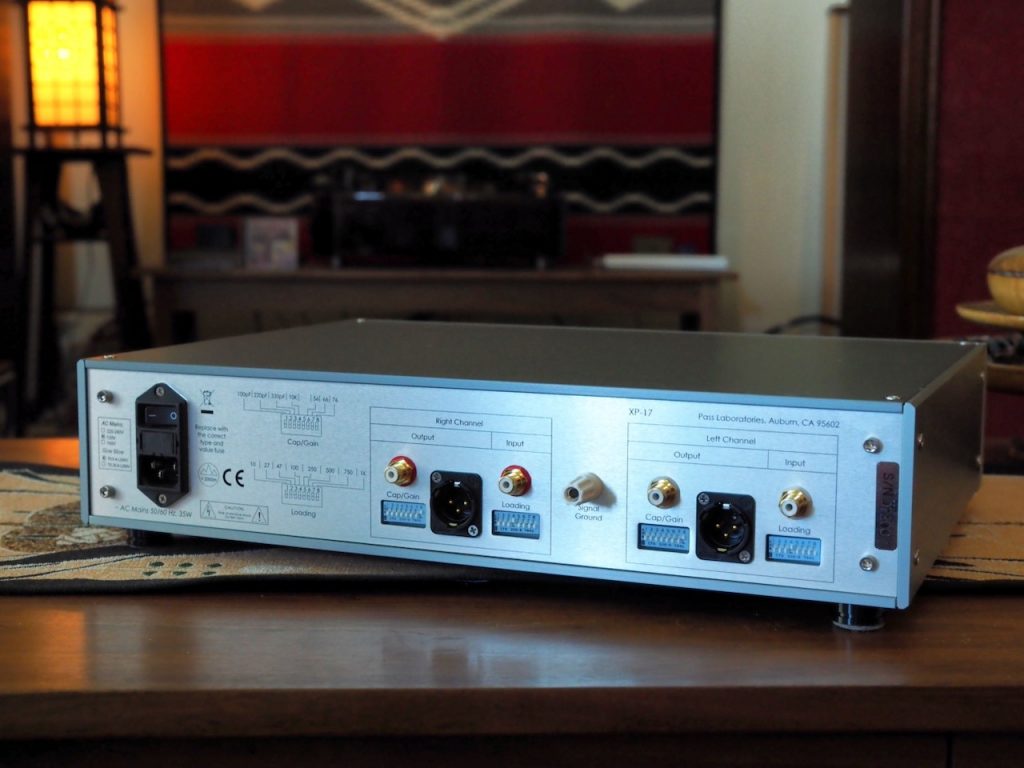
Pass Labs XP-17 phono preamplifier.
I'll go into all the design features of the XP-17 in its Positive Feedback review, but what I want to mention now about this Wayne Colburn designed phono preamplifier is its impressive adjustability.
To quote the XP-17's Owner's Manual:
"On the rear panel (photo above), you will see two sets of 8 pole DIP switches for each channel, these switches allow you to select gain, and adjust cartridge loading. Next to the IEC inlet you will see graphic representation of how the two pairs of switches interact.
"Cartridge loading can be adjusted from a couple ohms to 47k-Ohms, with a parallel capacitance from 100 pF to 750 pF. The default setting with all loading switches in the “OFF” position is 47k-Ohm and 100 pF."
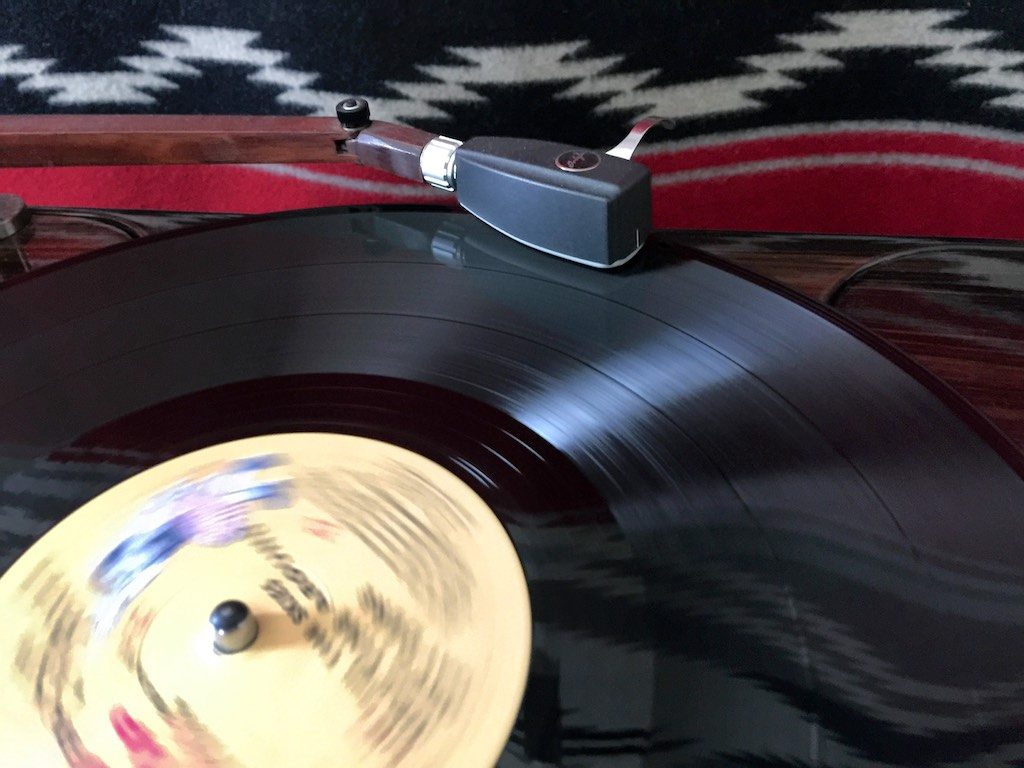
Ortofon SPU Classic GM MkII moving-coil phono cartridge.
The XP-17's manual gives some suggestions for settings for moving-coil, moving-magnet, and moving-iron, and rather remarkably, the user can choose between 2^8 resistive loading selections by varying the positions of the switches.
For this particular review, I'm going to primarily use the XP-17 phono preamplifier with moving-coil cartridges, like my Ortofon SPU Classic G MkII (above) ...
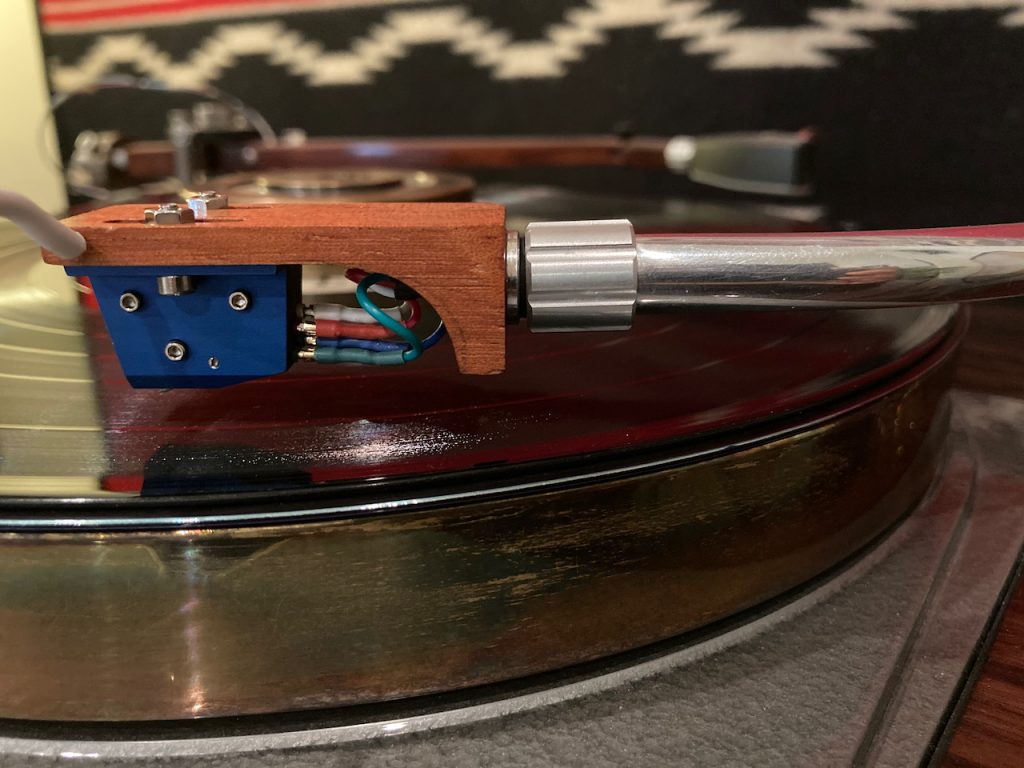
Audio Note (UK) IO I moving-coil phono cartridge.
... the Audio Note (UK) IO I that is in for review (above), and the previously reviewed Murasakino Musique Analogue ‘Sumile' (photo below, review HERE).
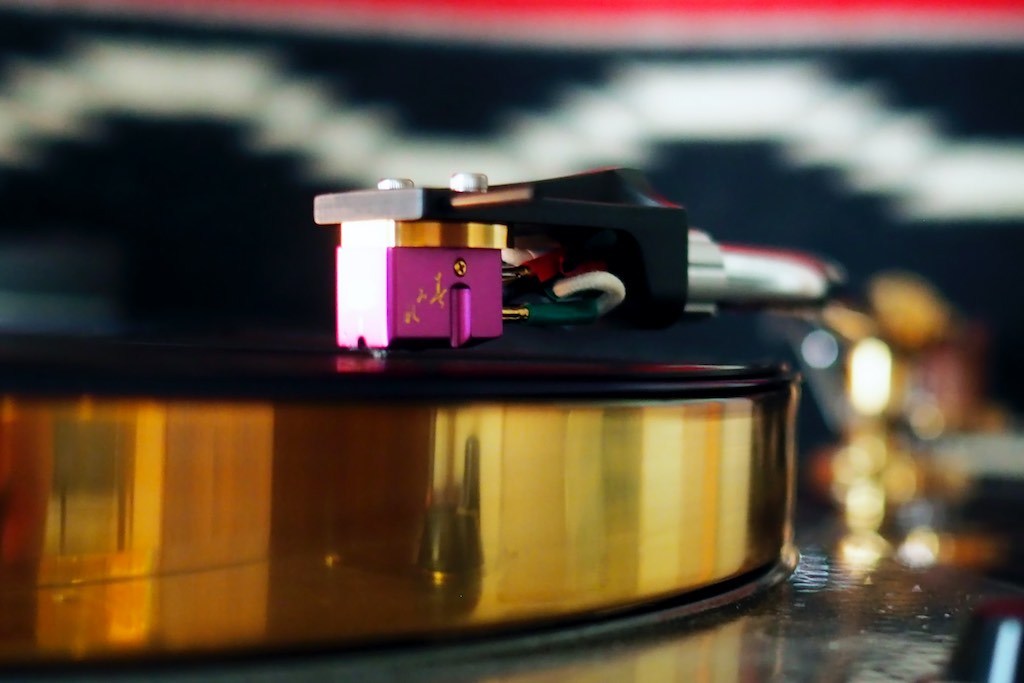
Murasakino Musique Analogue Sumile moving-coil phonograph cartridge.
These three moving-coil cartridges span the price range of about $1100 USD (Ortofon SPU Classic GM MkII), $4,132 USD (Audio Note (UK) IO I), and $8500 USD (Murasakino Musique Analogue ‘Sumile’), and all feature rather unique design parameters to achieve particular musical & sonic voicing goals, so they should give me a good feel for the XP-17's moving-coil phono cartridge versatility.
At the moment, the only cartridge I've experimented with optimizing the settings of the XP-17 for is the Ortofon SPU Classic GM MkII moving-coil cartridge with its 18 µm spherical stylus profile, and the result is impressively musical, dynamic, sonically adept, and natural sounding.
The adjustability of the XP-17 is impressive, and here's what the Owner's Manual recommends as steps for getting a moving-coil cartridge dialed-in:
Gain Settings
"To operate the Pass Labs XP-17 as a moving-coil pre-amp you should most likely start with 66 dB gain. If the output proves too low then 76 dB is more appropriate."
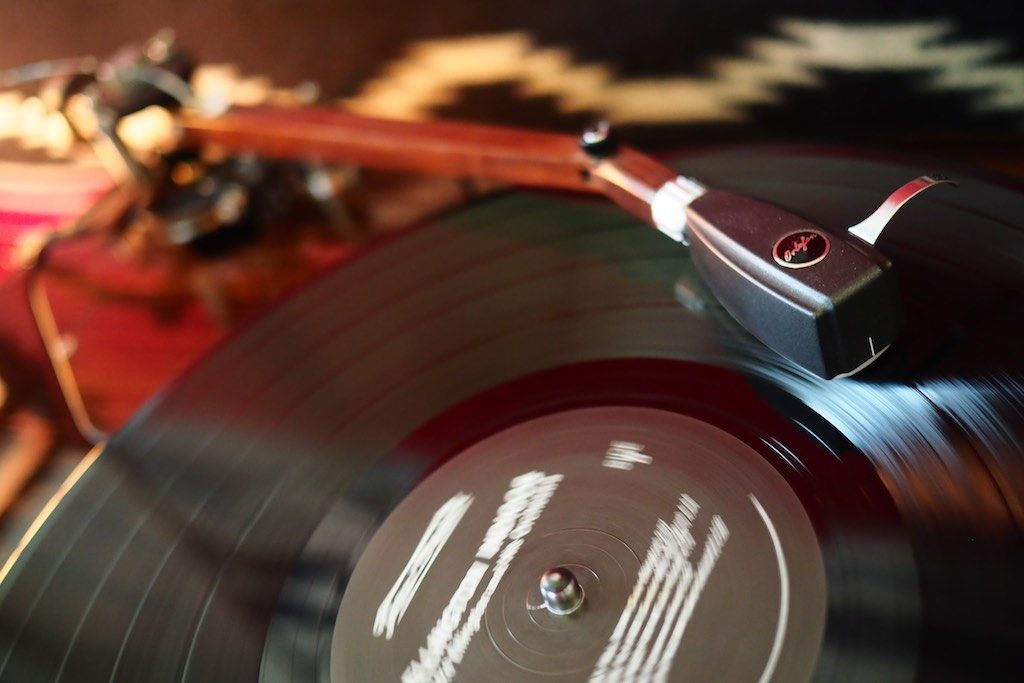
Ortofon SPU Classic GM MkII moving-coil phono cartridge.
For the Ortofon SPU Classic GM MkII's 0.2mV of output the 66 dB setting for gain wasn't enough, so I went for the 76 dB of gain setting, which provided all the gain I needed for natural live-like levels for this particular system setup.
Resistive Loading
The Owner's Manual goes on to say:
"The predominate loading effect on moving-coil cartridges will be resistive loading, adding capacitance may in some cases selectively reduce perceived output at higher frequencies.
"Resistively the XP-17 has a fixed input value of 47k-ohms and user selectable values of 10, 27, 47, 100, 250, 500, 750, and 1K. Selecting “On” for any of these values places that value in parallel with the 47k-ohm or any other value selected. From a purely mathematical perspective this gives a possible 2^8 resistive loading selections according to Ohm’s law for parallel resistors."
I'm still experimenting with resistive loading for the Ortofon SPU Classic GM MkII, but I have tried settings for 10, 27, and 47 Ohms, and among those, I liked listening with the 47 Ohm setting, which sounds very nicely balanced. I'll try more settings to hear what happens.
Capacitive Loading
The next step after setting the resistive loading is to set the capacitive loading:
"After you have selected a resistive cartridge loading that gives the best overall spectral balance and the most dynamic presentation you may choose to add or subtract capacitive loading to slightly trim the high-end response."
The range of capacitive loading values available with the XP-17 are 100pF – 750pF. I haven't experimented with capacitive loading yet. I started with 100pF and that sounds quite nice, but I want to try some other values to hear what happens.
The Owner's Manual says:
"The correct value is that which gives the best overall tonal balance. Typically, if the cartridge sounds too bright more capacitive loading will be required.
"Cartridge loading is a compromise between what works best for the cartridge and what sounds best for the listener. Specifically, we are looking for a compromise loading which sounds best across the whole audio spectrum."

System photo January 2021.
I should mention that a great deal of my time is spent getting a system setup dialed-in for a review by trying multiple combinations of equipment until I find the one I think gets the best out of the component to be reviewed, in this case the Pass Labs XP-17 phono preamplifier.
I have been listening with the Pass Labs XP-12 pre and XP-17 phono pre combination with my vintage Duelund-Altec Project "Stokowski" Altec loudspeakers (article HERE), along with the First Watt SIT-3 and F8 amplifiers, and the result was superb.
However, given Nelson and Wayne use Tannoy 15-inch dual concentric drivers in custom cabinets to voice and evaluate their designs, I thought it would be appropriate to move my Duelund-Westminster Project (article HERE) Tannoy Westminster Royal Special Edition loudspeakers into the system in place of the Altecs for the review of the XP-17 phono preamp.
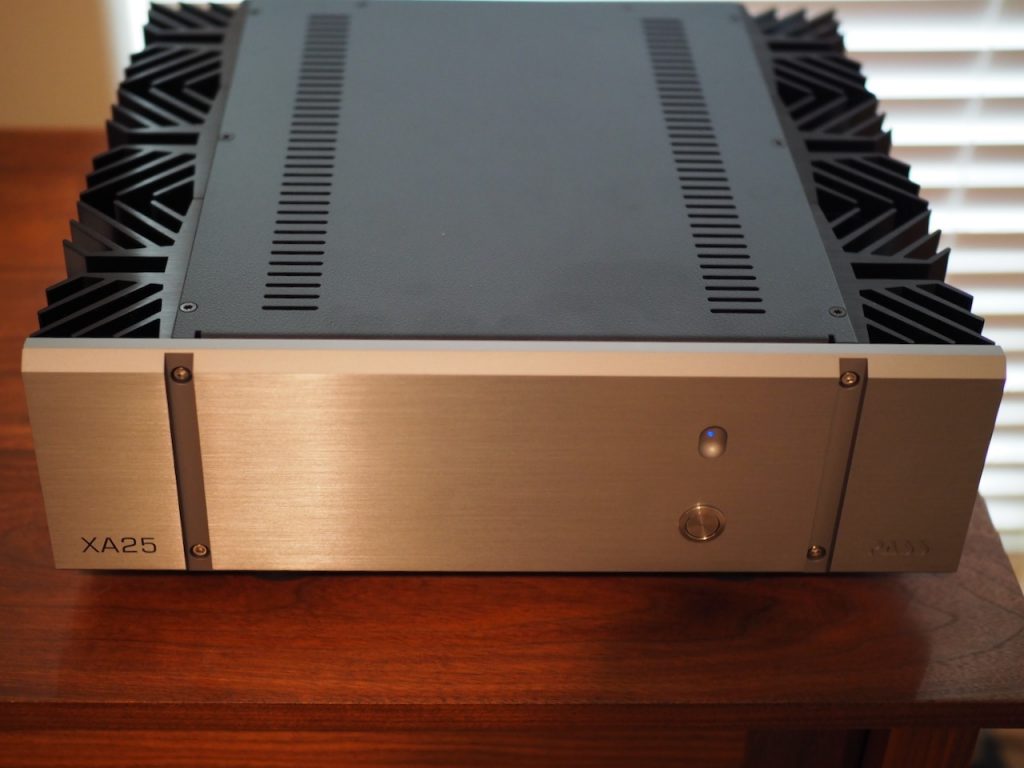
Pass Labs XA25 Class A stereo power amplifier.
First of all, I thought the Westminsters would give me a better idea of Nelson's and Wayne's intended voicings for their designs, and secondly, I want to include cameo appearances of both the Pass Labs XA25 stereo amplifier (photo above, review HERE) and First Watt F8 stereo amplifier (photo below) in the XP-17 review, as I hadn't heard them yet with the Westminsters. I may include the First Watt SIT-3 stereo amplifier for another data point as well.
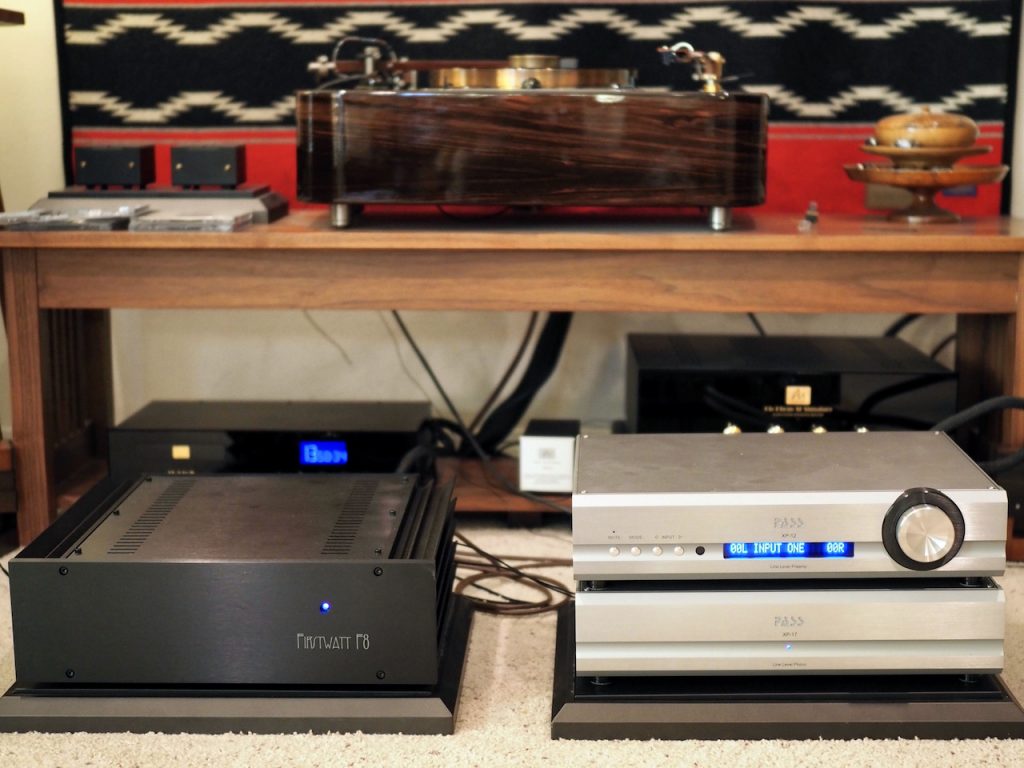
First Watt F8, Pass Labs XP-17 phono and XP-12 preamplifier.
I started with the newly released First Watt F8 stereo amplifier in combination with the Pass Labs XP-17 and XP-12.
I was a little concerned that the F8 (more HERE) might not be powerful enough with its 25 watts into the Westminsters 8 Ohms to get the best out of them, but those concerns turned out to be unfounded, as the F8 has provided nicely live-like volume levels with the music I've listened to so far. The F8 is a superb sounding stereo amplifier, which I'll comment more on in due time.
The next step was to optimize cable selections for this combination of loudspeakers, sources, and electronics, and after experimentation with several sets of cables, I found I preferred tinned-copper cables over silver cables, for example, in this particular system setup.
I'm using a shielded Duelund DCA16GA interconnects between the XP-17 phono and XP-12 pre, Belden 8402 tinned-copper microphone cable interconnects between the XP-17 phono and F8 amplifier, and Duelund DCA16GA speaker cables. I'm using Acoustic Revive power cables for First Watt F8, and Pass Labs XP-17 and XP-12. This combination of cables provides a very natural and live-like sound quality to the system.
The Westminsters are sounding extremely good with this combination of equipment. The musicality is superb, and the Westminsters give more insights to the characteristics of different recordings than do my "Stokowski" Altecs.

Duelund-Altec Project "Stokowski" Altec loudspeakers.
Conversely, while the "Stokowski" Altecs don't give as much insight in the characteristics of different recordings as the Westminsters, but they do give more insights into the artistic elements and emotional content of the music being listened to.
Both the Altecs and Westminsters are awesome loudspeakers that I enjoy immensely, and they both offer different views into the performance of associated equipment, so it can be handy to swap them in and out of the system to hear how different components responds to them.

Jeff being a dopey tourist at Stonehenge.
The only downside of having these sets of gigantic loudspeakers in my listening room is it makes it feel like I'm sitting in a loudspeaker "Stonehenge" at times. Oh what we go through for audio!
Now that I have the basics for the review system roughed out, the next steps are to try the Pass Labs XA25 amplifier, then in addition to the Ortofon SPU Classic GM MkII, to try the Audio Note (UK) IO I and Murasakino Musique Analogue ‘Sumile’ moving-coil phono cartridges to hear what happens.
I'll keep you posted on those little experiments as I get a chance to try them in the system, so stay tuned for more on the Pass Labs XP-17 phono preamplifier here at Jeff's Place.
As always, thanks for stopping by, and may the tone be with you!



























